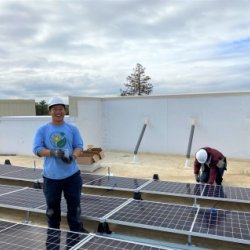Considerations for Solar on Your Commercial or Multifamily Property
By Bakari Touray, Multifamily and Commercial Solar Project Developer
So, you’re interested in going solar for your multifamily or commercial building? Great!
Solar PV (photovoltaic) technology has made great strides in the last decade and it’s easier now than ever to have your own system installed. However, while we would love to power every building with sunshine, there are many factors to consider when evaluating your building or site for a solar PV system. Not all solar systems are built equal. A system made from the exact same panels and inverters can end up producing significantly different amounts of energy based on a myriad of factors around the system itself.
The last thing we at GRID Alternatives North Valley would want to do is leave you with a system that doesn’t meet your hopes and expectations, so here are some guidelines to help you understand if your site is solar-ready:
First off, a quick science lesson. You likely already know that the earth rotates on an axis roughly perpendicular to the sun, which means that the sun shines most directly on the equator. It gets a bit more complicated than that, but the important thing to know is that for us in the Northern Hemisphere, that means that the sun’s rays actually come from the south. Therefore, one of the most important factors in a solar panel’s production is how much its arrays are angled to the south, where the sun’s rays can hit the panel’s cells most directly. If we were to compare it to the face of a clock where 12 o’clock is north and 6 o’clock is south, a solar array will generate the most amount of energy if faced directly at 6 o'clock.
The further away from this, the less energy it will produce. Anywhere southwest or southeast is still very viable, and systems facing directly east or west will still produce a decent amount of energy, but once they start facing even slightly north, you will see a significant dropoff in production. Some regions won’t even allow a solar contractor to install a system that faces anywhere north for this reason. So, if your building has a tilted roof, the more available space there is on its south-facing roof planes, the better. If your building has a flat roof, your panels can be installed sitting up at an angle, so this becomes less of an issue. Unfortunately, if the only available space on your roof is on its north-facing planes, you may not be in a good position to go solar.
Here are some other important factors to consider:
-
Available space. If your roof has a lot of HVAC units, vents, or other obstructions, we may not be able to fit enough panels to generate a meaningful amount of energy for your building. There are also fire code regulations to consider, meaning that if your roof consists of many small planes instead of a few large ones, it may not be a great fit. There are other options, however! If your site has ample space in a parking lot or field, it’s possible that you could be a good candidate for a carport, shade structure, or ground mount solar array.
-
Shade. Solar panels need access to direct sunlight, so if your building is surrounded by trees or other, taller buildings that might cast shadows on your rooftop at certain times in the day, your total energy consumption could be drastically reduced. Typically if those trees or buildings are located to the north of your building though, this won’t be much of an issue. Tree trimming can be a viable option to help fix this issue, but you’ll need to consider the cost-benefit analysis of both the initial tree-trimming work and the work that will need to be done once those trees grow back in a few years’ time.
-
Roof material and condition. Solar panels are heavy and meant to be on your roof undisturbed for decades, so if your roof is old or made of fragile materials like ceramic tiles or wood shake, you will need to factor in roof work to your budget when considering a solar PV system. A roof under ten years old and made from composite shingle or TPO membrane is the ideal candidate, but this isn’t necessarily a disqualification in most situations.
It’s our goal at GRID to do everything we can to help you see the most savings and greenhouse gas reductions possible with your solar PV system. If you think you have a great site for solar, or would like a professional evaluation of your site at no cost, please contact Bakari Touray at btouray@gridalternatives.org, or by phone at (916) 588-9782.

